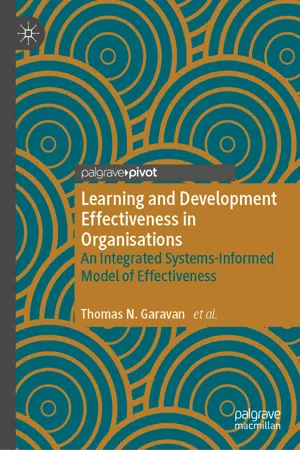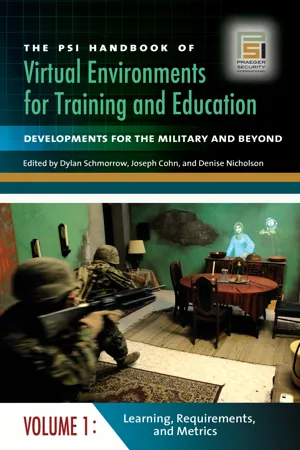Business
Training Effectiveness
Training effectiveness refers to the extent to which a training program achieves its intended outcomes and objectives. It is measured by assessing the impact of training on employee performance, skills development, and overall organizational goals. Evaluating training effectiveness helps businesses determine the return on investment and make informed decisions about future training initiatives.
Written by Perlego with AI-assistance
Related key terms
1 of 5
10 Key excerpts on "Training Effectiveness"
- eBook - PDF
- Josiane Fahed-Sreih(Author)
- 2020(Publication Date)
- IntechOpen(Publisher)
It is unstructured and occurs outside a learning institution [11]. Figure 1 shows the relationships between training and learning. Training, either off-the-job, on-the-job, or online, involves transferring expertise and knowledge from experts who have it to novices who need it [14]. Both training and learn-ing activities consist of a process of knowledge sharing, which is an element of reciprocity and is a giving-taking exchange process of information or assistance to others [15]. Knowledge sharing between employees and across teams allows an organization to exploit existing knowledge-based resources and has been identified as a positive force in creating innovative organizations [15–17]. 2.2 Model of Training Effectiveness In a competitive environment, while employee training and learning have become an increasingly important strategic issue for organizations [8], the core concern is how to help the company and trainees receive benefits from the train-ing activities? The related questions include “what kind of factors that may affect the success and effectiveness of training” and “what/how trainers can do to make training program effective?” Training Effectiveness, according to Noe ([4], p. 216), refers to “the benefits that the company and trainees receive from training.” It focuses on understanding the whole learning system to determine why learners learn or do not. It also explains why the learning results happen and assists training Figure 1. The relationships between training and learning. Career Development and Job Satisfaction 28 designers to make troubleshooting to improve training [18]. Thus, theoretically, Training Effectiveness is the study of the individual, training, and organizational characteristics that influence the training process before, during, and after training [18]. Training Effectiveness differs from the training evaluation. - eBook - ePub
- Geri McArdle(Author)
- 2010(Publication Date)
- AMACOM(Publisher)
Let’s begin by reviewing the definitions of some key terms and processes that pertain specifically to evaluation. You should have become familiar with these because of their use in earlier chapters of this book, but they particularly pertain here:Training Effectiveness refers to the benefits that the company and the trainees experience as a result of training. Benefits for the trainees include acquiring new knowledge, learning new skills, and adopting new behaviors. Potential benefits for the company include increased sales, improved quality, and more satisfied customers.Training outcomes or criteria refer to measures that the trainer and the company use to evaluate the training.Training evaluation refers to the collection of data pertaining to training outcomes, needed to determine if training objectives were met.Evaluation design refers to the system from whom, what, when, and how information is collected, which will help determine the effectiveness of the training.Because companies have made large dollar investments in training and education, and they view training as a strategy to be more successful, they expect the outcomes or benefits of the training to be measurable. Additionally, training evaluation provides a way of understanding the investments that training produces and provides the information necessary to improve training. Figure 6-1 shows the interlocking nature of training evaluation.Figure 6-1. Interlocking nature of training evaluation.The Evaluation of Training
We end this book as we began, discussing the success of a training program. From the start, all efforts to define a need for training, through design and implementation, were aimed at achieving measurable success. It’s time to review the process for determining that success. Ultimately, the evaluation leads to improvements in the program (content, instructional strategies, pace, or sequencing).Thus, evaluation is a significant part of the design and development process. While we usually think of evaluation as something that takes place during or after the training, it really is critical to the entire process. And the heart of evaluation is the assignment of value and the making of critical judgments. The evaluation process measures what changes have resulted from the training, how much change has resulted, and how much value can be assigned to these changes. - eBook - PDF
Organizational Effectiveness
The Role of Psychology
- Ivan T. Robertson, Militza Callinan, Dave Bartram, Ivan T. Robertson, Militza Callinan, Dave Bartram(Authors)
- 2003(Publication Date)
- Wiley(Publisher)
TRAINING 125 organizational effectiveness. For example, when using subjective or soft mea-sures (as in cross-sectional studies) into production and service as well as in-vestor outcomes, research needs to account for organizational factors such as how well espoused the link between training and organizational strategy is, and how clearly and widely organizational performance (such as productivity, revenue and profit data) is communicated to, and understood by, those asked to share their perceptions of training impact. Also, external factors such as market conditions and business/political cycles should be taken into account wherever feasible. Indeed, as well as the challenge in designing adequate studies to iden-tify both direct and indirect links and interactions, a significant challenge is the issue of communication and the way in which training evaluations are translated into metrics that are meaningful within a specific organizational context. ANSWERING THE QUESTION: DOES TRAINING IMPROVE ORGANIZATIONAL EFFECTIVENESS? The evidence from our review suggests that training does improve organiza-tional effectiveness in the following ways: Targeted skills and role/business (contextually) focused training increases HR outcomes in the form of job behaviours related to production and service outcomes. Contingent on business direction and conditions, the impact of training on HR, production and service outcomes may transfer to investment outcomes as measured by ROI and ROE indices, and as perceived by stock market valuations (which would be consistent with the increased interest in human capital and employee value-added indices among financial circles). This interpretation is supported by the findings that training is related to in-vestment outcomes in organizations that are capital intensive (Koch & McGrath, 1996) and when there is commitment to strategic planning (Bracker & Cohen, 1992; Newkirk-Moore & Bracker, 1998). - eBook - PDF
- Max Messmer, Anne M. Bogardus, Connie Isbell(Authors)
- 2015(Publication Date)
- Wiley(Publisher)
6.1 Determining What Training Can Do For You No matter what the nature of your business, you won’t find it easy to stay on top without a commitment to helping your people stay ahead of emerging trends and changing needs. Increasing the knowledge of your workforce not only enhances your ability as a company to compete but also makes for more satisfied employ- ees. Even in lean times, cutting back on training to reduce expenses can be counterproductive, both in terms of company success and employee retention. 6.1.1 Evaluating Your Training Situation Now, more than ever, learning is a highly individual process, and because of that you must be wary of taking the “one-size-fits-all” approach. In general, here are some of the factors that most often influence the effectiveness of a program, regardless of which form it takes: ▲ Receptivity level of students: Consider the extent to which participants are open and receptive to the concepts that are covered in the training. Do your best to communicate to all potential participants the specific learning objectives of the course and how they will benefit. ▲ Applicability of subject matter: The success of any program will hinge largely on whether participants believe that what they’re being taught has direct relevance to the challenges they face in their jobs. Ensure that the workshop focuses on issues that are the most important to participating employees. ▲ The overall learning experience: Training sessions should be as interac- tive and participant-oriented as possible. The best courses use a variety of learning tools: lecture, discussion, and exercises. ▲ Quality of instructor: A big factor in determining the effectiveness of a program is the ability of the trainers (whether they’re giving live presentations or are on videotape) to capture and sustain the interest of participants. - Surbhi Jain(Author)
- 2019(Publication Date)
- Society Publishing(Publisher)
The trainer may feel that they have achieved their behavioral objectives when in reality the benefits are short lived. In a study conducted by Tennant, Boonkrong, and Roberts (2002), an assessment of the methods utilized to conduct evaluations in UK-based manufacturing plants was conducted. They also sought to determine the barriers that are associated with the implementation of effective training programs. It was concluded that a majority of the firms opined that most of the training programs did not help them to achieve higher levels of productivity. A link between better job performance and quality was also difficult to establish. It was explained by the fact that the training was inadequate. A measurement model needed to be created to ensure that the evaluation Evaluating the Effectiveness of the Training and Development Programs 231 process was effective. It shows that the attitudes of the firm’s towards the training process plays a role on determining whether evaluation takes place. At the same time, the evaluation can help reveal details on whether different approaches need to be taken in the programs. Wise decisions must be taken when designing training and development and the evaluations. The study by Borate, Gopalkrishna, and Borate (2014) sought to evaluate the effectiveness of a training program in a multinational company. The Kirkpatrick’s model was utilized as a method of evaluation. Questionnaires were utilized as the method of obtaining data. The elements of reaction, learning, behavior, results were considered in coming up with the questions. It was concluded that after a few months of training, there was a change in the worker’s behavior. Their confidence in handling difficult tasks had increased. The workers also indicated that their expectations for the training programs had been met. Based on the results, it is clear that using the right method of evaluation may yield the results that a firm seeks for.- eBook - ePub
Skill Acquisition and Training
Achieving Expertise in Simple and Complex Tasks
- Addie Johnson, Robert W. Proctor(Authors)
- 2016(Publication Date)
- Routledge(Publisher)
10Designing Effective Training Systems
Without a knowledgeable and skillful workforce, organizations are likely to suffer. With that in mind, training in organizations should be of the utmost importance. E. Salas, K. A. Wilson, H. A. Priest, & J. W. Guthrie (2006, p. 503)Throughout this book we have described techniques for training different types and components of skill. We have discussed factors influencing skill acquisition and have discussed the major models of how skill is acquired. In this chapter we argue that there is more to training than the application of techniques for acquiring skill. Effective training programs are built on an understanding of the task being trained for, the people being trained, and the environment in which the trained task will be performed. Not only will the quality of the design and delivery of the program influence training success, but so will the attitudes and the motivation of the trainees and the organizational context (Noe, 1986). The success of any training program will thus depend on gaining the support of trainees and the organization and on removing any barriers to implementing trained knowledge or skills. Given that motivation, ability, and organizational factors all play a role in the success of training programs, it is not surprising that training is an interdisciplinary research area, with contributions from the fields of cognitive and industrial/organizational psychology, human factors and ergonomics, instructional design, and human resource management.Assessing Training Requirements
According to common wisdom, the first phase of training program development for specific skills should be needs assessment (I. L. Goldstein & Ford, 2002). Needs assessment involves determining what knowledge or skills are prerequisite to training activities and what the goals of the training should be. It should be viewed as an ongoing process in which the organization acts proactively, anticipating training needs and any barriers to implementing training. Needs assessment focuses on identifying specific problem areas in the organization and determining whether training is an appropriate solution to the problems. - Surbhi Jain(Author)
- 2019(Publication Date)
- Society Publishing(Publisher)
For an instance, in an organization, if a certain type of technical training is conducted, then the organization would be more interested to know whether the implementation of new skills is being used up at the workplace or in other words, whether the productivity of the worker is enhanced due to the training programs or not. Same can be assessed in the case of behavioral training, where a person can be evaluated based on the changes occurred in his behavior, attitude or learning ability. 7.2. EVALUATION OF TRAINING Any process in an organization needs to be evaluated and assessed for its benefits (or disadvantages) in terms of costs and productivity. Same is the case with training. Evaluation of training is nothing but comparing post-training results to the benchmarks or standards set by the managers, trainers, and apprentices, to some extent. Training is a time consuming and costly method and hence, not many organizations think of even imparting it internally. Also, often it has been seen that training is conducted without any intention of measuring its results thereafter. But, industry experts recommend that training results should be assessed; the management axiom – “nothing will improve unless it is measured” – applies to train as well. One way to evaluate training is to study and analyze its cost-benefit ratio. Comparing costs and benefits is easier; they can be assigned monetary denominations and used for further assessments. The best way is to calculate the value of total output before and after training. Any increase would indicate that training has proved to be instrumental. However, costs and benefits should be carefully measured; it might be a task in certain situations. Therefore, benchmarking training has grown as a popular practice among organizations. HR Solutions for Excellence in Training & Development 238 7.2.1. Benchmarking Training Figure 7.2: Traditional training process.- Rebecca Herold(Author)
- 2010(Publication Date)
- CRC Press(Publisher)
The education activity had a noticeable impact on business practices in your area □ □ □ □ □ h. The time it took for your personnel to participate in the training or awareness activity □ □ □ □ □ i. The cost in dollars to your area for your personnel to participate in the training or awareness activity. □ □ □ □ □ j. The activity supports applicable regulatory requirements and/or demonstration of due diligence □ □ □ □ □ 5. Please describe what can be improved: Evaluate Education Effectiveness ◾ 279 Exhibit 11 Effectiveness Evaluation Framework: Training Example Training: Information Security Fundamentals Date: December 10, 2011 Been Given? Yes Baseline Measurement? No Executive Support? Yes Target Group: All new hires globally Group Size: Unknown Delivery Method: CBT Module International Next Delivery Date: Ongoing Goals: Notes/Observations: General Effectiveness Indicators: Your answers to the following questions can be incorporated into an executive summary report covering the effectiveness of your training or awareness activity. Answer by using the information from the forms on the following pages. 1. Access. a. What groups are you reaching? b. What groups are missing? c. What is the participation rate for the group? d. Are you providing appropriate delivery methods for your target audiences? e. Can all your target audiences access your training and awareness materials and participate in your delivery methods? 280 ◾ Managing an Awareness and Training Program 2. Relevancy. a. Is your education program relevant to your organization’s business goals and expectations? b. Are your training and awareness messages and information relevant to job responsibilities? c. Will your education program have a noticeable impact on business practices? d. Was your training content appropriate for your target participants? e. Did your training cover regulatory and policy requirements? 3.- eBook - ePub
Learning and Development Effectiveness in Organisations
An Integrated Systems-Informed Model of Effectiveness
- Thomas N. Garavan, Fergal O’Brien, James Duggan, Claire Gubbins, Yanqing Lai, Ronan Carbery, Sinead Heneghan, Ronnie Lannon, Maura Sheehan, Kirsteen Grant, Fergal O'Brien(Authors)
- 2020(Publication Date)
- Palgrave Macmillan(Publisher)
A related question concerns the effectiveness of face-to-face versus virtual methods. A number of meta-analyses present different and somewhat conflicting findings. Sitzmann et al. (2006) for example, found that web-based training was more effective than face-to-face training; however, Lacerenza et al. (2017) found in the context of leadership training, that face-to-face was more effective. Howard and Gutworth (2020) investigated different types of virtual reality training and found that virtual reality training programmes, on average, performed better than alternative approaches to developing social skills. Gamified training produced slightly lower levels of learning than programmes that utilised non-immersive displays. How Relevant is the Training Content in Explaining Training Effectiveness? A number of meta-analyses provide insights on this question. Both Burke and Day (1986) and Taylor et al. (2009) found that learning outcomes were influenced by the content trained. Bezrukova et al. (2016) for example found that training that emphasised awareness type objectives had lower effect sizes compared to attitudinal- and behavioural-focused content. Lacerenza et al. (2017) found that the outcomes were more significant for training that focused on skills. They found that soft-skills training enhanced organisational and individual outcomes compared to hard skills content. How Important Are Individual Transfer Versus Organisational Transfer Characteristics in Explaining Training Effectiveness? Several meta-analyses provide us with insights on this question. Hughes et al. (2019) for example, found that work environment factors explained unique variance in transfer. Individual characteristics such as motivation to learn, mediated the work environment—transfer link. Peer and supervisor support were particularly important in explaining long-term training transfer. Blume et al - eBook - PDF
The PSI Handbook of Virtual Environments for Training and Education
Developments for the Military and Beyond [3 volumes]
- Joseph V. Cohn, Dylan Schmorrow, Denise Nicholson, Joseph V. Cohn, Dylan Schmorrow, Denise Nicholson(Authors)
- 2008(Publication Date)
- Praeger(Publisher)
This chapter provides one such approach, starting with analyses to identify specific training goals and objectives, and then defining the types of scenario ele- ments necessary to realize these goals. The results from these early analyses can then be used to inform system design, support iterative usability analyses that should be interspersed through the development cycle, and guide the develop- ment of a training management component that ties together the other elements into a cohesive training system. Last, training system effectiveness may be deter- mined by quantifying system utility across several levels: reaction, which focuses on training usability; learning, which quantifies how well the system provides the necessary information; behavior, which provides insight into the degree to which performance is improved; and results, which demonstrate long-term impact to the organization through the use of the developed system. Ideally, all four levels would be determined through a comprehensive TEE; in practice, however, con- straints may force some levels to be emphasized over, or to the exclusion of, others. Done well, though, these trade-offs may be made, and the assessments performed, in a way that still allows all those involved to understand the overall utility of the training system REFERENCES Alvarez, K., Salas, E., & Garofano, C. M. (2004). An integrated model of training evalu- ation and effectiveness. Human Resource Development Review, 3(4), 385–416. Bloom, B., Englehart, M., Furst, E., Hill, W., & Krathwohl, D. (1956). Taxonomy of edu- cational objectives: The classification of educational goals. Handbook I: Cognitive domain. New York: Longmans, Green. Boldovici, J. A., Bessemer, D. W., & Bolton, A. E. (2002). The elements of training effec- tiveness (Rep. No. BK2002-01). Alexandria, VA: The U.S. Army Research Institute. Brown, J. (2002). Training needs assessment: A must for developing an effective training program.
Index pages curate the most relevant extracts from our library of academic textbooks. They’ve been created using an in-house natural language model (NLM), each adding context and meaning to key research topics.









